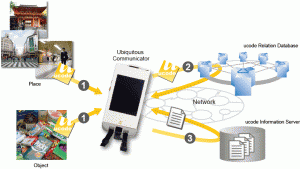The ucode system is a numeric value of 128-bit length, and has no meaning in itself. The information associated with ucode is stored in a distributed database on network. The terminal that obtained ucode retrieves the attributes and semantic information of ucode according to the following steps. This procedure is called a “ucode Resolution” (Figure 1).
- Read ucodes assigned to objects or places.
- Make an inquiry to the distributed database about the read ucode and obtain the address of the server providing attributes and semantic information related to the ucode (URL, etc.).
- Obtain the information related to ucode from the obtained server.
With a search engine, you need keywords to retrieve information on the objects and places in front of you. With the ucode resolution server, retrieving information on objects and places is possible if their ucodes alone can be obtained even when you don't know anything (clues) about the object or place you would like to inquire about.

Figure 1: Mechanism of ucode Resolution
Distributed Management of ucode Resolution
The server that provides ucode resolution function is called a ucode resolution server. The ucode resolution servers are interconnected, as distributed servers with a hierarchal structure, based on the scope of ucode. Meanwhile, terminal searches interconnected resolution server in sequence by using the standardized API that ucode resolution client library provides, and then retrieves attributes and semantic information related to the ucode.


